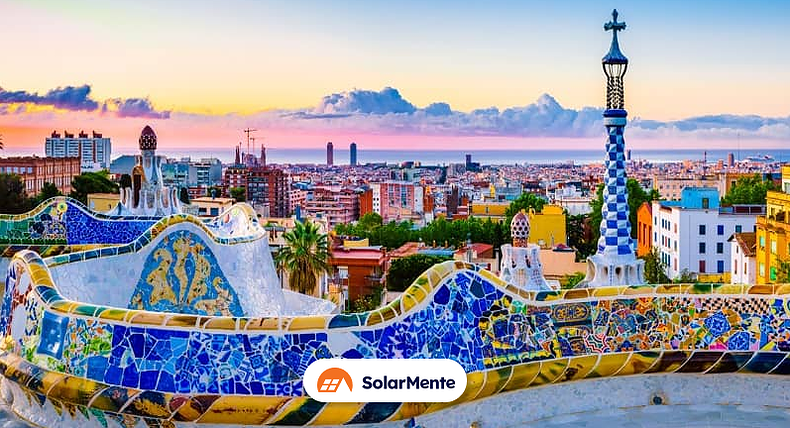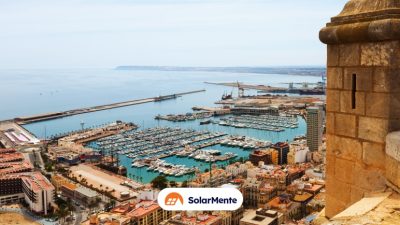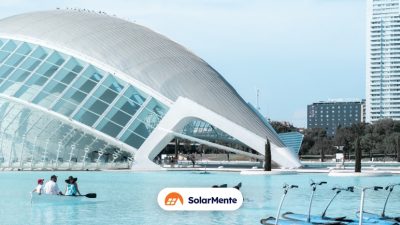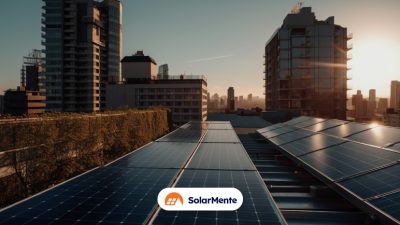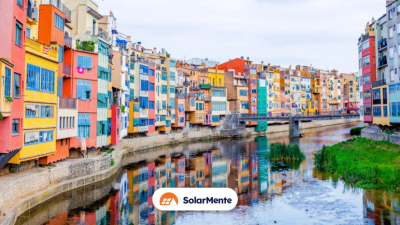The installation of solar panels in Barcelona is in full expansion thanks to the favourable conditions of the geographical area.
High hours of sunshine per year, subsidies and regional aid, competitive prices and high photovoltaic production. All these factors have positioned the region as an alternative for self-consumption for homes, where solar energy is increasingly present and affordable for the population.
The potential of the city of Barcelona surpasses other European cities thanks to its higher solar irradiation. But before making any investment, it is important to detail all the considerable factors that we will detail in this article:
-
Grants and subsidies in Barcelona
-
The photovoltaic production capacity
-
The prices of the installation
-
The compensation of surpluses
-
How to orientate the photovoltaic system
-
How much savings can be generated with solar panels
-
How to switch to self-consumption without initial investment
Grants and subsidies for solar panels in Barcelona
As in other Spanish cities, there are a number of subsidies available for installing solar panels in Barcelona to facilitate the move towards self-consumption. Here are the available subsidies:
-
ICIO rebate
-
IBI rebate
-
Personal income tax deduction
- Next Generation self-consumption subsidies
The subsidies for installing solar panels differ depending on the municipality you are in and can change at any time. Therefore, it is important to always check this information before making the investment.
Barcelona is one of the most benefited provinces in Spain.
Let’s see what they are.
ICIO rebates in Barcelona
The maximum ICIO rebate that can be obtained is 95%. Although this rebate represents only 2-3% of amortisation, a large number of municipalities in the province have access to the maximum percentage of aid.
In the following table, you have all the available data depending on the locality:
| Municipality | Population | % ICIO rebate | Conditions |
| Areys de Mar | 15.942 | 95% | Provided that the energy is not commercialised |
| Argentona | 12.629 | 95% | In existing or existing or new new buildings |
| Badalona | 223.006 | 50% | Min. 25%. Max 95%. Pot>1kWp. May not exceed the price of the installation |
| Badía del Vallés | 13.228 | 95% | – |
| Barberà del Vallès | 33.016 | 95% | – |
| Barcelona | 1.636.732 | 95% | – |
| Berga | 16.682 | 50% | – |
| Caldes de Montbui | 17.797 | 75% | – |
| Calella | 19.236 | 95% | – |
| Canet de Mar | 14.810 | 95% | – |
| Canovelles | 16.872 | 95% | – |
| Cardedeu | 18.609 | 95% | – |
| Castellas del Vallès | 24.659 | 95% | – |
| Castelbisbal | 12.610 | 50% – 95% | 30% of the contracted pot. electricity contracted. For non-residential 50% |
| Castelldefels | 67.226 | 95% | – |
| Cerdanyola del Vallès |
57.217 | 95% | – |
| Corbera de Llobregat | 15.017 | 50% | For % of autoproduction equal to or more than 30% of self-production |
| Cornellà de Llobregat |
89.300 | 35% | – |
| Esparreguera | 22.358 | 95% | – |
| Esplugues de Llobregat |
46.777 | 95% | – |
| Franqueses del Vallès, Les |
20.351 | 95% | 20% in new buildings new buildings |
| Garriga, La | 16.733 | 40% | – |
| Gavà | 46.931 | 90% | – |
| Granollers | 62.475 | 95% | – |
| Hospitalet de Llobregat, L’ |
264.657 | 95% | – |
| Igualada | 40.875 | 50% | – |
| Llagosta, La | 13.259 | 95% | – |
| Malgrat de Mar | 18.950 | 95% | – |
| Manlleu | 20.804 | 50% – 95% | For self-consumption 95% isolated. Grid connected 50%. |
| Manresa | 78.192 | 95% | – |
| Mantorell | 28.667 | 95% | – |
| Masnou, El | 23.848 | 95% | – |
| Mataró | 129.120 | 95% | – |
| Molins de Rei | 26.104 | 50% – 75% | All |
| Mollet del Vallès | 51.151 | 95% | – |
| Montcada i Reixac | 36.794 | 95% | – |
| Montgat | 12.260 | 75% – 95% | 95% if min. 50% of primary energy consumed, and 75% if min. 25%. |
| Montornès del Vallès | 16.804 | 95% | – |
| Olesa de Montserrat | 24.132 | 50% | – |
| Palau-solità i Plegamans |
14.917 | 95% | – |
| Piera | 16.411 | 90% | – |
| Pineda de Mar | 27.974 | 95% | – |
| Prat de Llobregat, El | 65.532 | 95% | – |
| Premià de Dalt | 10.419 | 95% | – |
| Premià de Mar | 28.523 | 95% | – |
| Ripollet | 39.139 | 95% | – |
| Roca del Vallès, La | 10.676 | 95% | – |
| Rubí | 78.549 | 95% | In dwellings of 10 or more years old more than 10 years old |
| Sabadell | 216.204 | 95% | Max. 50% of the cost |
| Sant Adrià de Besòs | 37.283 | 95% | – |
| Sant Andreu de la Barca |
27.175 | 95% | – |
| Sant Andreu de Llavaneres |
11.150 | 90% | – |
| Sant Boi de Llobregat |
83.755 | 50% – 95% | 50% for non-residential residential |
| Sant Celoni | 18.176 | 95% | – |
| Sant Cugat del Vallès | 94.012 | 95% | – |
| Sant Feliu de Llobregat |
45.463 | 95% | – |
| Joan de Vilatorrada | 10.871 | 95% | – |
| Sant Just Desvern | 19.379 | 95% | – |
| Sant Pere de Ribes | 31.525 | 50% | – |
| Sant Quirze del Vallès |
20.156 | 95% | – |
| Sant Sadurni d’Anoia | 12.840 | 90% | – |
| Sant Vicenç dels Horts |
28.115 | 95% | – |
| Santa Coloma de Gramenet |
119.289 | 95% | – |
| Santa Margarida de Montbui |
10.192 | 95% | – |
| Santa Perpètua de Mogoda |
26.033 | 95% | – |
| Sitges | 30.217 | 95% | – |
| Terrassa | 223.011 | 50% | – |
| Tordera | 17.788 | 60% | – |
| Torelló | 14.553 | 95% | Individuals registered in the with an income less than 40.000€/year for two members, proportional proportional value for more members |
| Vallirana | 15.438 | 95% | – |
| Vic | 47.319 | 90% | – |
| Viladecans | 66.707 | 95% | – |
| Vilafranca del Penedès |
39.969 | 95% | – |
| Vilanova del Camí | 12.736 | 75% | – |
| Vilassar de Mar | 20.936 | 95% | – |
IBI rebates in Barcelona
IBI rebates vary from one municipality to another. There are a large number of towns that can enjoy the maximum percentage of IBI for up to 5 years.
The list is as follows:
| Municipality | Town | % IBI rebate | Years | Use to which it applies | Conditions |
| Abrera | 12.620 | 33% | 3 | Residential | – |
| Areys de Mar | 15.942 | 50% | 5 | Residential | Pot>1kWp |
| Argentona | 12.629 | 50% | 3 | All | Max. bonus < price of the installation |
| Badalona | 223.006 | 50% | 4 | All | Pot>1kWp. Max. 300€/year |
| Badía del Vallés | 13.228 | 50% | 3 | Residential | – |
| Barberà del Vallès | 33.016 | 50% | 5 | All | – |
| Barcelona | 1.636.732 | 50% | 3 | All | – |
| Berga | 16.682 | 50% | 4 | – | – |
| Calella | 19.236 | 50% | 2 | – | – |
| Canovelles | 16.872 | 50% | 5 | – | – |
| Cardedeu | 18.609 | 40% | 5 | All | – |
| Castellas del Vallès | 24.659 | 50% | 3 | – | – |
| Castelbisbal | 12.610 | 50% | 3 | Residential | Min. 30% of the electricity energy supply. 10% for common services |
| Castelldefels | 67.226 | 50% | 5 | All | Pot>1kWp |
| Cerdanyola del Vallès |
57.217 | 50% | 5 | All | Bonif. Max. 500/year. Max. 2.500 € |
| Corbera de Llobregat | 15.017 | 50% | 12 | All | For % of autoproduction equal to 30% or more |
| Cornellà de Llobregat |
89.300 | 10% | 3 | All | – |
| Esparreguera | 22.358 | 25% | 5 | All | Max. 300€/year |
| Franqueses del Vallès, Les |
20.351 | 20% | 5 | – | – |
| Garriga, La | 16.733 | 50% | 5 | Residential | – |
| Granollers | 62.475 | 50% | 5 | Residential | – |
| Llagosta, La | 13.259 | 50% | 3 | Residential | – |
| Lliçà d’Amunt |
15.673 | 50% | 5 | Residential | |
| Manlleu | 20.804 | 50% | 5 | Residential | According to installed installed indicate the maximum amount of bonus: <1kW: 0€ ; ≥1 and <2 kW: 250€; ≥2 and < 3 kW: €300; ≥ 3 and < 4 kW 400 €; ≥ 4 and < 5 kW 500 €; ≥ 5 kW 550 |
| Manresa | 78.192 | 30% | 2 | Residential | – |
| Mantorell | 28.667 | 10% – 50% | 5 | Residential | – |
| Masnou, El | 23.848 | 50% | 3 | All | According to installed installed |
| Mataró | 129.120 | 50% | 3 | All | – |
| Molins de Rei | 26.104 | 35% – 50% | 5 | Residential and commercial |
Installed power>30%. Contracted power. Dwellings multi-family dwellings, common services, rebate of 5%. Activities economic activities rebate of 50%, maximum 50% of of the cost of installation and limit 1000€/year. |
| Mollet del Vallès | 51.151 | 50% | 5 | Residential and commercial |
Min. 25% of electricity energy supply. 5% for multi-family multi-family dwellings, 30% for commercial commercial use |
| Montcada i Reixac | 36.794 | 50% | 5 | All | – |
| Montornès del Vallès | 16.804 | 50% | 5 | Residential | Minimum 30% of the electricity energy supply. Dwellings multi-family dwellings, 5% rebate. |
| Olesa de Montserrat – | 24.132 | 50% | 10 | All | 50% up to fifth year, 45%, 45 6th year, 40% All seventh year, 35 eighth year, 30% the ninth year and 25% in the tenth year |
| Palau-solità i Plegamans |
14.917 | 50% | 3 | All | – |
| Pallejà | 11.636 | 50% | 5 | All | Min. 30% of the power contracted. If covers common common elements of the multi-family house 5% of bonus |
| Parets del Vallès |
18.907 | 50% | 5 | Residential | Max. 50% of the cost of the installation |
| Piera | 16.411 | 50% | 3 | – | – |
| Pineda de Mar | 27.974 | 50% | 1 | Residential | – |
| Prat de Llobregat, El | 65.532 | 50% | 3 | Residential | Max. 300€/year |
| Premià de Dalt | 10.419 | 25% | 5 | – | – |
| Premià de Mar | 28.523 | 50% | 7 | – | – |
| Ripollet | 39.139 | 50% | 5 | – | – |
| Roca del Vallès, La | 10.676 | 50% | 5 | – | – |
| Ruby | 78.549 | 50% | 5 | Residential | Min. 30% of of electricity electricity |
| Sabadell | 216.204 | 50% | 5 | Residential | – |
| Sant Andreu de la Barca |
27.175 | 30% | 3 | – | Supply of 50% of the of electricity energy consumed. 5% for shared self-consumption. shared. |
| Sant Andreu de Llavaneres |
11.150 | 50% | 3 | Residential | Min. 30% of the electricity 30% of electricity supply. 5% self-consumption shared |
| Sant Boi de Llobregat |
83.755 | 50% | 5 | All | – |
| Sant Celoni | 18.176 | 10% – 30% | 3 | Residential | Total bonus< to cost of installation |
| Sant Cugat del Vallès | 94.012 | 50% | 5 | Residential and commercial |
Min. 50% of electricity electricity supply. 5% self-consumption shared and commercial. Variable for multi-family multi-family dwellings 5- 50% |
| Sant Feliu de Llobregat |
45.463 | 50% | 5 | Residential | – |
| Joan de Vilatorrada | 10.871 | 10% – 20% | 3 | Residential | 10% new housing new housing |
| Sant Just Despí | 34.130 | 50% | 3 | All | – |
| Sant Just Desvern |
19.379 | 50% | 10 | All | Max 33% cost installation. 3 years non-residential. Multi-family bonif. 5% per dwelling |
| Sant Pere de Ribes | 31.525 | 50% | 3 | All | -Pot>1.5 kWp |
| Sant Quirze del Vallès |
20.156 | 50% | 5 | All | – |
| Sant Sadurni d’Anoia | 12.840 | 50% | 3 | Residential | Pot>800 Wp. Pot>500 Wp*no. of residents |
| Sant Vicenç dels Horts |
28.115 | 25% | 5 | Residential | – |
| Santa Margarida de Montbui |
10.192 | 50% | 3 | – | – |
| Santa Perpètua de Mogoda |
26.033 | 5% – 50% | 3 | Residential | Min. 30% of electricity 30% of electricity supply. 5% self-consumption shared. Max. 300 €/year |
| Sitges | 30.217 | 50% | 3 | Residential | – |
| Terrassa | 223.011 | 50% | 5 | All | Pot. Min. 1,800 Wp and 900 Wp for self-consumption collective |
| Tordera | 17.788 | 50% | 2 | Residential | – |
| Torello | 14.553 | 50% | 5 | All | According to installed installed power 2 |
| Vallirana | 15.438 | 30% | 10 | All | – |
| Vic | 47.319 | 50% | 5 | Residential (urban) | The % depends on the certificate energy certificate |
| Viladecans | 66.707 | 50% | 3 | Residential | Max. 50% of the budget of the installation |
| Vilafranca del Penedès |
39.969 | 50% | 2 | All | Pot>1kWp. Max. 60% of the cost of the installation |
| Vilanova del Camí | 12.736 | 50% | 3 | – | – |
| Vilanova i la Geltrù |
67.458 | 10% – 50% | 3 | Residential | The % depends on the cost of installation, the energy savings savings and the whether it is single-family or multi-family |
| Vilassar de Mar | 20.936 | 50% | 4 | Residential | – |
The Next Generation self-consumption subsidies
There are even more subsidies: the Next Generation subsidies.
This is another plus in addition to the IBI and ICIO rebates that do not depend on the municipalities, but are part of the Recovery, Transformation and Resilience Plan to help avoid dependence on conventional electricity and promote self-consumption in the country.
What are the amounts established by the plan?
Well, we have two cases:
-
For installations with a peak power of less than 10 kWp, the aid will be €600 per kWp of installation and €490 in the case of adding storage batteries.
-
The amount will vary between €450 and €300 for large installations exceeding 10 kWp.
One more fact to mention: those municipalities with less than 5,000 inhabitants on urban land will receive a higher aid for self-consumption, adding €55 per kWh in the installation and €15 in the battery.
If you want to find out more about the content of the subsidies, we recommend you take a look at the Generalitat’s website.
The IRPF deduction
Let’s finish with the IRPF deductions.
The aim is to encourage energy efficiency with a deduction applicable to 20% of the total investment made, regardless of whether we are talking about a single-family home or a community of neighbours,as long as it is not related to an economic activity.
The maximum deduction is 5,000 euros per year.
Photovoltaic production in Barcelona: why install solar panels in the Catalan province?
Barcelona is a city with a privileged location in terms of climate.
We refer to the facts. It has an average of 2,453 hours of sunshine per year plus a solar irradiation of 2,059 kWh/m2.
Let’s take a simple example.
A 3.4 kWp system has an annual production of more than 5,000 kWh with a loss of 20%.
OK, but is this data good or not?
If we compare it with Germany, the leading country in Europe in terms of solar PV penetration, its capacity to produce solar energy is significantly lower, 3,227 kWh.
Therefore, Barcelona’s potential has not yet been fully exploited.
This gives the area a large capacity for generating solar energy for homes.
All this impliesthe following benefits that you will be able to take advantage of from the first minute of installation:
-
You can save up to 50% (or more) on your electricity bill.
-
You forget about the continuous fluctuations in prices, reaching excessive amounts.
-
You reduce CO2 emissions by using clean, renewable energy.
What’s more, if you don’t consume it immediately, you can store the energy in the solar batteries or even feed the surplus into the conventional electricity grid to receive financial compensation.
Prices of solar panels in Barcelona
There is no standard price for solar panels.
Why can’t we point out a fixed cost? For the simple reason that each installed system has a different dimension. Each house has specific needs and prices vary from one community to another.
However, you should know that the price does not only include the materials, i.e. the solar panels, but also other factors that are included in the same amount. These are:
-
The materials
-
The labour
-
The legal formalities to install the system
The following table shows the approximate prices we use at SolarMente to install the solar panels:
| Solar panels | Prices |
| Kit M | 6.786€ |
| Kit L | 8.114€ |
| Kit XL | 9.538€ |
Surplus compensation
Once Royal Decree 244/2019 was published, the possibility of receiving a certain amount of money for homes with self-consumption installations in the event of not using all the energy produced by the solar panels was announced.
This money is received for producing more energy than you spend and is known as surplus compensation.
Therefore, you will receive “x” amount of money when you feed the surplus into the grid.
But be very careful with this. We don’t want to create confusion about this. The established price per kWh of this compensation is much lower than the price we pay when using the conventional electricity grid, we are talking about 0.06€ approximately. This has nothing to do with the electricity prices we pay today.
With this we want to make it clear that we do not overdimension the system by this compensation because it is not a profitable business.
Moreover, you will only receive an amount until the portion of the bill that varies reaches zero.
Our advice?
Go to professionals in the sector to install a system that fits your energy consumption, no more and no less. At SolarMente, we offer you personalised advice for a correct installation.
Solar panels inclination in Barcelona
To receive more solar radiation it is necessary to have the correct orientation and inclination of the solar panels. This is the way to efficiently capture solar energy and achieve the maximum performance of the system.
In short, if you live in Barcelona, the ideal orientation is south and an inclination of 40º.
How much can you save with a solar panel installation in Barcelona?
Now, let’s put it into practice.
And what better than to put an example on the table to clarify the concepts.
Firstly, the Catalan capital receives an average of 5.6 HSP (peak solar hour) with a correct tilt of 40º.
Secondly, this territory gets almost 2,500 hours of sunshine a year. We are talking about one of the European regions with the most days of sunshine, therefore, the production it generates is relevant.
Well, let’s suppose that a family consumes 5,000 kWh per year (approximate consumption). The photovoltaic system to cover these needs would include about 8-10 panels. This means that the savings could exceed 800 euros per year on the electricity bill, i.e. more than 60%. A marvel!
In addition, thanks to the subsidies and aid provided by the government and local councils, the payback period for the investment would be around 7-8 years.
Depending on the conventional electricity grid, Spanish households with a consumption of 2,500 – 5,000 kWh are paying 43% per kWh more than other neighbouring countries in the European Union, according to the latest report published by the European Commission (EC) electricity markets.
Finally, if you want to know the subsidies provided in the remaining provinces of the Catalan community, here is the list:
-
Solar panels in Tarragona
-
Self-consumption in Lleida
-
Installation of solar panels in Girona
How to switch to self-consumption without initial investment
From here, you now have all the information you need to go solar in the city of Barcelona.
However, there is not only the option of buying the system in cash. You can also choose to rent solar panels with our solar subscription model, in which you will not have to make a large initial investment, but a single monthly payment where you will have the following advantages:
-
You can continue to enjoy IBI and ICIO subsidies.
-
Sell the energy you do not consume.
-
Guaranteed guarantees against any system failure.
-
Save on your electricity bill and enjoy clean energy.
In conclusion
Barcelona is a city with many hours of sunshine per year that allow a high solar production, but it is important to consider the singularities of each municipality to make the right decision and maximize the performance of your solar panels.
If you want to install solar panels in Barcelona and start enjoying clean and economical energy, you only have to try our self-consumption calculator.

